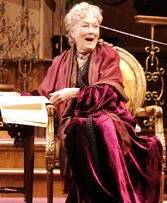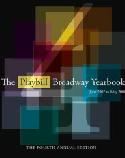SITE GUIDE
SEARCH
REVIEWS
REVIEW ARCHIVES
ADVERTISING AT CURTAINUP
FEATURES
NEWS
Etcetera and
Short Term Listings
LISTINGS
Broadway
Off-Broadway
NYC Restaurants
BOOKS and CDs
OTHER PLACES
Berkshires
London
California
New Jersey
DC
Connecticut
Philadelphia
Elsewhere
QUOTES
TKTS
PLAYWRIGHTS' ALBUMS
LETTERS TO EDITOR
FILM
LINKS
MISCELLANEOUS
Free Updates
Masthead
A CurtainUp Review
The Royal Family
By Elyse Sommer
|
I'm sick of being a Cavendish. I want to be a human being.—Gwen, the youngest member of the theatrical royals, her determination to marry a show business outsider clearly intended to end up being upstaged by the family's unshakable love affair with the theater. |

Rosemary Harris as Fanny Cavendish
(Photo: Joan Marcus) |
Even if Aubrey Cavendish Stewart, the youngest heir to the family's standing as theatrical royals were to pick up and run with the torch, it would take him to a far less grand playing field. He'd be as likely to star in a ninety-minute intermissionless solo play with minimal scenery, as a 15-character extravaganza, and if he aspired to living in the grand manner of an East Side Manhattan duplex with uniformed houseboys, it would be paid for mostly with earnings from film and TV work (actually Lionel Barrymore was already moving in his direction when he played the irascible Doctor Gillespie in the popular 1930s and 1940s Doctor Kildare movies).
And so, given the times we live in — a time when the Redgraves, their tree tragically cut by the death of Natasha Richardson, are one of the few families following in the theatrical dynasty tradition. . . when bottom line conscious producers prefer simple over spectacular. . . when busy audiences tend to prefer trim and pacey — this A-cast revival of Edna Ferber and George S. Kaufman's 1927 screwball comedy and ode to the theater is sure to thrill anyone yearning to re-experience a by-gone era. On the other hand, those less smitten with antiques will find it only intermittently funny and wonderful and rather ho-hum.
For me, even with those those great dames of the theater, Rosemary Harris and Marian Seldes (Fanny in Royal Family revival I saw at Williamstown a dozen years ago) The Royal Family nowadays can't quite lick the ho-hum factor. The best bon mots land too occasionally to hide the feeling that this is an antique that's been restored with the dust motes of age clinging to much of its three acts.
As plots go The Royal Family is slim, basically a portrait of the flamboyant Barrymores (with some fictional additions) during a period of crisis: The ill health of the family matriarch, the granddaughter's conflict about entering the family business or marriage; the movie star brother's constant scrapes with the law; the push and pull of her family's needs, her career, as well as the return of a long absent and still adoring suitor on Julie Cavendish, the family's reigning Broadway diva.
The whole idea is to spoof the over-the-top lives of these once known to all thespians and at the same time pay tribute to actors for whom the theater demands sacrifices worth making because it represents life at its passionate best.
The first act is more or less a set-up to introduce us to the family. Rosemary Harris is lovely and imposing as the the ailing Fanny who's determined to die on stage (like her late husband). The fact that Harris played Julie Cavendish in the 1975 opposite another stage great, Eva Le Gallienne, undoubtedly adds to the nostalgia appeal of this production. Harris has a wordless bravura scene during the play's best and most emotional strong final scene that almost makes me tempted to pull out that critic's cliche about some aspect of the play being worth the price of the ticket. Fortunately, Jan Maxwell's Julie (the character modeled on Ethel Barrymore) also has such a bravura moment when her life as Broadway diva, devoted mother, daughter and loyal sister get the best of her at the end of the second act.
Kelli Barret like her character, the young Cavendish crown princess, is making her Broadway debut, as is Freddy Arsenault as her suitor. Both are attractive and adequate but this revival's other best moments come from the larger than life characters who show up in the gorgeously appointed duplex (who but John Lee Beattie could create this exquisitely furnished architectual Wow?): Reg Rogers shamelessly and deliciously chewing up the gorgeous scenery as Julie's magnet for trouble brother Tony (as was the real life John Barrymore); a fictionalized family member, Fanny's down on his theatrical luck brother Herbert Dean (John Glover) and his abrasive wife Kitty (Anna Gasteyer). Kitty yearns for Cavendish stardom but complains that " I've had the royal family Cavendished up to me for twelve years. " According to her husband she was" just an off stage noise" when he met her. There's also David Greenspan, best known to and loved by downtown theatergoers, doing a hilarious twist on the stiff upper lip butler one usually sees in these old-fashioned plays.
While Fanny Cavendish's illness leads to a poignant but sad ending for this comedy, Tony Roberts has happily made a quick recovery from an onstage seizure shortly before the official opening. He's back and in fine form as the Cavendish family's devoted but pragmatic business manager Oscar Wolfe. On and Off-Broadway regular Larry Pine nicely fits the part of Gilbert Marshall, the rich businessman who has come back into Julie's life just when she seems to need him.
Doug Hughes is a director with impeccable credentials — but as it turns out he's more a master of drama (Doubt, Inherit the Wind, Frozen) than zany comedies. Thus, while things improve after the sluggish expository first act, he leans heavily on having each act build towards chaotic scenes with everyone talking, or rather shouting, at once. Hughes is at his best in the final act when he vividly stages the outsider status of Gwen's Perry and Julie's Gilbert, by having them talking to each other upstage, apart from the Cavendish clan; also, when Fanny plays her final scene and Julie gathers her in her arms.
As John Lee Beatty's set is a major applause-deserving character, so are Catherine Zuber's costumes. One of the narrators in the new Off-Broadway hit, Love, Loss and What I Wore, talks disparagingly of her mother's buying her an outfit, a look she considers passé I think she'd change her mind if she saw Jan Maxwell's first outfit — a stunning red dress, with matching, fur-trimmed coat. For that matter all the outfits, including the men's, make their own statements.
The Royal Family is one of those plays that has people saying "They don't make them like that any more." So I suppose, it will be occasionally revived as long as there are companies like Manhattan Theatre Club with it's built-in audience of people who'd like to revisit those good old days, complete with the de rigeur two intermissions and the fun of well-behaved dog extras. To prove it, here are links to three Royal Family reviews we've caught since going on line: The Royal Family with Marian Seldes at Williamstown, 1996. . .Royal Family in London 2002. . . Royal Family, Marian Seldes again, Los Angeles 2004
|
Subscribe to our FREE email updates with a note from editor Elyse Sommer about additions to the website -- with main page hot links to the latest features posted at our numerous locations. To subscribe,
E-mail: esommer@curtainup.comesommer@curtainup.com
put SUBSCRIBE CURTAINUP EMAIL UPDATE in the subject line and your full name and email address in the body of the message -- if you can spare a minute, tell us how you came to CurtainUp and from what part of the country. |
|
The Royal Family Playwrights: George S. Kaufman and Edna Ferber Director: Doug Hughes Cast: Ana Gasteyer (Kitty Dean), John Glover (Herbert Dean), Rosemary Harris (Fanny Cavendish), Jan Maxwell (Julie Cavendish), Larry Pine (Gilbert Marshall), Tony Roberts (Oscar Wolfe), and Reg Rogers (Tony Cavendish). They are joined by Freddy Arsenault (Perry Stewart), Kelli Barrett (Gwen Cavendish), Caroline Stefanie Clay (Della), Rufus Collins (McDermott, Gunga), David Greenspan (Jo), Anthony Newfield (Chauffeur), Henny Russell (Miss Peake), Cat Walleck (Hallboy), and John Wernke (Hallboy). Sets: John Lee Beatty Costumes: Catherine Zuber Lighting: Kenneth Posner Sound: Darron L. West Hair & Wig Design: Tom Watson: Original Music: Maury Yeston Fight Direction: Rick Sordelet Stage Manager: Rick Steiger Animals: William Berloni Running Time: 2 hours and 45 minutes with 2 intermissions Manhattan Theater Club at Samuel J. Friedman Theatre 261 West 47th Street From 9/15/09; opening 10/08/2009; closing 12/17/09. Reviewed by Elyse Sommer October 11th |
|
REVIEW FEEDBACK Highlight one of the responses below and click "copy" or"CTRL+C"
Paste the highlighted text into the subject line (CTRL+ V): Feel free to add detailed comments in the body of the email. . .also the names and emails of any friends to whom you'd like us to forward a copy of this review. |






